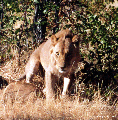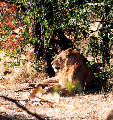| [an error occurred while processing this directive] |
[an error occurred while processing this directive]
Botswana Safari
All images are the property of mongabay.com (Nancy Butler), copyright 1994.
Contact mongabay regarding use and reproduction.Recommended travel guides on Botswana
Recommended travel guides on Botswana: 

Lion [Wikipedia]: [an error occurred while processing this directive] The Lion (Panthera leo) is a mammal of the family Felidae. The male lion, easily recognized by his mane, may weigh up to 250 kg (550 lb). Females are much smaller, weighing up to 180 kg (400 lb). In the wild lions live for around 10�14 years, while in captivity they can live over 20. Lions are predatory carnivores who live in family groups, called prides, consisting of related females, their cubs of both sexes, and one or more unrelated males who mate with the adult females. The females do the hunting for the pride while the males are largely occupied with maintaining the borders of their territory. Males are expelled from the pride when they reach maturity. When or if a male coalition takes over a pride and ousts the previous coalition, the conquerors often kill any cubs that they did not father. Lions are one of the most sexually active cats. During a female's estrus cycle, a male and female will mate unabated for 5-7 days every 10 to 20 minutes. However, it takes 6-9 estrus cycles for the female to become pregnant. Overview Despite its popular moniker of "King of the Jungle", the lion is an animal of the open plains, and can be found on the savannas of much of Sub-Saharan Africa. It is nevertheless a threatened species with significant populations being limited to national parks in Tanzania and South Africa. Before the rise of man, the species existed on more territory than any other land mammal. The last remnant of the Asiatic Lion (subspecies Panthera leo persica), which in historical times ranged from Greece to India through Persia, lives in the Gir Forest of northwestern India. About 300 lions live in a 1412 km� (558 square miles) sanctuary in the state of Gujarat. Lions had become extinct in Greece, their last European outpost, by 100 AD, but they survived in considerable numbers in the Middle East and North Africa until the early 20th century. The lions that used to live in North Africa, called Barbary lions, tended to be larger than the sub-Saharan ones, and the males had more extensive manes. They are thought to have been a subspecies of lion (Panthera leo leo), although this has not been confirmed. Other extinct subspecies are the Cape Lion, and the European Cave Lion (subspecies Pathera leo spelaea) which coexisted with humans throughout the last Ice Age. Lions are recurring symbols in the coat of arms of royalty and chivalry. Lions appear in the art of China, even though lions have never lived in China. No animal has been given more attention in art and literature. C.A.W. Guggisberg, in his book Simba, says the lion is referred to 130 times in the Bible. The lion can be found in stone age cave paintings. Although they are not often heard of due to their rarity, white lions do exist, in Timbavati, South Africa. There is a recessive gene in white lions that gives them their unusual color (also causing white tigers, many white tigers with this gene are bred for zoos and animal shows). A white lion has a disadvantage when it comes to hunting; their white color can give away their hiding place. Lions in the wild Like all other cats, lions are superpredators, but unlike all other cats they are social hunters and take prey too large and dangerous to overpower singly, including adult zebras, cape buffalo, giraffes, hippopotamuses, and even sub-adult elephants, although fully-grown elephants are far too dangerous even for them to tangle with. Singly, they can generally take on any animal smaller than themselves easily, including wildebeest, antelope, gazelles, and warthogs. Lions living near beaches are known to have killed seals as prey. Singly, a lion kills with the neck bite that breaks the neck or severs vital blood vessels; several lions may pin a large prey animal while another delivers the lethal neck bite or suffocates the prey by covering the victim's muzzle, preventing breathing. Lions are not averse to scavenging, and they frequently drive off smaller or outnumbered predators from kills and take the prey. Lions too can be driven off from prey by such competitors as hyenas and wild dogs in overwhelming numbers. Like other cats they have superb night vision that makes them more effective at night. They can sleep as many as 20 hours in a day. The lionesses, despite modest size, do the bulk of the hunting and killing. As a rule, all of the females of a pride are related (grandmothers, aunts, mothers, sisters). Male lions exist largely to defend the pride; excellent fighters (the mane on lions is an evolutionary adaptation to fighting; the mane absorbs bites and scratches that might otherwise be lethal), but due to their large size and difficulty at concealment, they are ineffective predators. The male lion gets his share of all kills by his pride. Lionesses 'own' their hunting grounds. Most prey animals remain calm if they spot a lion; the lion lacks the stamina for a sustained chase, in contrast to wild dogs. Natural enemies include such competitors as crocodiles, hyenas, and wild dogs, but especially other lions. Some of the prey animals (zebras, hippopotamuses, and elephants) can deliver crippling or killing blows by kicking or stomping. Lions are found throughout South Africa, Zimbabwe, Namibia, Botswana and Mozambique. They are mainly found in woodland type areas but can survive in semi desert or bush areas. Baby or young lions are called cubs. Females give birth to 1-5 youngsters, after a gestation period of three months. The cubs can suckle for as long as 18 months but are normally weaned by 8 weeks. They face a high mortality rate from starvation, attacks by other large predators, and especially by male lions killing the younger ones while taking over a pride. Attacks on humans While a hungry lion will probably attack a human that passes near, some (usually male) lions seem to seek out human prey. Some of the more publicized cases include the Tsavo man-eaters and the Mfuwe Man-Eater. In both cases the hunters who slew the lions wrote books about their exploits. In folklore, man-eating lions are sometimes considered demons. The Mfuwe and Tsavo incidents did bear some similarities. The lions in both the incidents were all larger than normal, lacked manes and seemed to suffer from tooth decay. Some have speculated that they might belong to an unclassified species of lion, or that they may have been sick and couldn't have easily caught prey. There have also been recorded attacks on humans by lions in captivity, most probably due to their reputation as proud, strong and dangerous animals, and the subsequent circus attractions such as lion taming which have developed from this. The major differences between lion subspecies are size, mane appearance and location. However, some display unique behaviour and adaptations, for example, the Kalahari lion is able to survive with very little water. All but one are situated in Africa, the exception being the Asiatic Lion.
Articles involving tourism in Botswana: [an error occurred while processing this directive] [an error occurred while processing this directive] |











